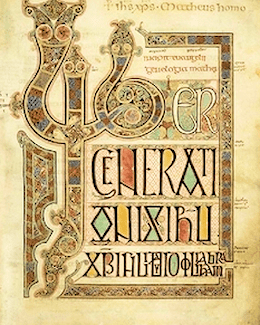Textus Receptus Bibles
Wessex Gospels c.1175
Anglo-Saxon
| 28:1 | Soðlice Note: MS. Sodlice. þam reste Note: restes, alt. to reste. -daiges efene. se þe on-lihte on þam forme reste-dayge com syo magdalenissca Marie & syo oðer Marie þæt hyo wolden ge-syen þa byrigenne. |
| 28:2 | & þær warð ge-worðen mychel eorð-befiunge. Witodlice drihtenes ængel ästah of heofene. & geneahlacte. ænd awelte þanne stan. & sæt þær on-uppon. |
| 28:3 | hys ansiene wæs swylce leyt. & hys reaf swa hwit swa snaw. |
| 28:4 | Witodlice þa weardes wæren afyrhte. & wæron ge-worðene swylce hyo deade wæren. |
| 28:5 | Ða andswerede se ængel & sayde þam wifon. Ne on-dræde ge eow. Ic wat witodlice þæt ge secheð þanne hælend. þane þe on roden ahangen wæs. |
| 28:6 | Nis he her. He aras ge-wislice swa swa he sæigde. Cumeð & geseoð. þa stowe þe se hælend wæs on aleigd. |
| 28:7 | & Fareð rædlice & cumeð & seggeð hys leorning-cnihten þæt he aras. & soðlice he cymð beforan eow on galileam. þær ge hine geseoð. nu ich segge eow. |
| 28:8 | Þa ferden hyo rædlice fram þare byrigenne mid eige & mid mychele ge-fean. & urnen ænd kydden hyt hys leorning-cnihten. |
| 28:9 | & efne þa com se hælend ongean hyo. & cwæð. hale wese ge. Hyo ge-neohlahten & ge-namen hys fët. & to him ge-eadmededon. |
| 28:10 | Ða cwæð se hælend to heom. Ne on-dræde ge eow. fareð & kyðeð mine ge-broðre þæt hyo faran on galilea. þær hyo ge-seoð me. |
| 28:11 | Ða hyo ferdon þa comen sume þa weardes on þa ceastre. & kyddan þare sacerda ealdren. ealle þa þing þe þær ge-worðene wæren. |
| 28:12 | Þa ge-samnode þa ealdres hyo. & worhten gemot. & sealden þam þeignen. mychel feoh. & cwæðen. |
| 28:13 | Seggeð þæt hys leorning-cnihtes coman nyhtas & for-stælen hyne þa we slepen. |
| 28:14 | Ænd gyf se dema þis ge-axoð. we læreð hyne. & ge-doð eow sorhlease. |
| 28:15 | Ða on-fengen hyo þas feos. & dyden eal-swa hyo ge-lærde wæren. & þis word wæs gewid-mærsod mid iudeam oðð þisne andwearden dayg. |
| 28:16 | Þa ferden þa endlefan leorning-cnihtes on þanne munt þær se hælend heom dihte. |
| 28:17 | & hine þær ge-seagen. & hyo to hym ge-eadmedoden Note: -mododen, alt. to -medoden. . Witodlice sume hyo tweonoden. |
| 28:18 | Ða ge-neohlacte se hælend ænd spræc to heom þas þing & þus cwæð. Me ys ge-seald ælch anweald on heofena & on eorðan. |
| 28:19 | fareð witodlice & læreð Note: MS. læred. ealle þeode. & fullieð hyo. on naman fæder & sune & þas halgen gastes. |
| 28:20 | & læreð þæt hyo healden ealle þa þing. þe ich eow be-bead. & ich beo mid eow ealle dages oððe worulde ændenge. Amen. |

Wessex Gospels c.1175
The Wessex Gospels (also known as the West-Saxon Gospels) are a full translation of the four gospels of the Christian Bible into a West Saxon dialect of Old English. Designated Royal MS 1 A XIV, it is historically important.
- The Wessex Gospels are the oldest translations into English without the Latin.
- The gospels are written in the Old English West Anglo-Saxon dialect of Northumbria.
- Royal MS 1 A XIV is written on parchment and is also known as the Codex Evangeliorum Anglice.
- The title written at the top of the page, ‘Text[us] iv evangelior[um] anglice’, is reproduced in the 14th-century catalogue of the Benedictine Christ Church library, but at the Reformation this book was one of many acquired from religious houses by Thomas Cranmer, Archbishop of Canterbury from 1532 to 1534, whose name is written at the top of the page.
- Seven extant copies exist today. The earliest version dates from 990AD.
- Royal MS 1 A XIV was copied directly from MS 441 in the Bodleian library at Oxford. We know this as the same passages have been omitted from both. It has a transmission jump of 185 years.
- MS 441 (990AD) is extant and still resides in the Bodleian Library at Oxford University, England. It was given to the library by Baron Hatton in 1671. Paleographical evidence suggests a Canterbury origin. The earliest extant evidence of ownership is through Archbishop Matthew Parker (1504-75).
- MS Corp. Ch Coll Camb 140 (1000AD) is in Corpus Christi College Cambridge.
- Royal MS 1 A XIV (1175AD) is in the British Library and was presented to the British Museum by King George II in 1757 from the Old Royal Library.
- Royal MS 1 A XIV once belonged to the Prince of Wales: Henry Frederick, (1594-1612), eldest child of King James the First.
Why is this important?
- Desiderius Erasmus had access to these MSS before starting his translation of the Textus Receptus. In the five years prior to starting his translation work Erasmus was Professor of Divinity at Cambridge at a time when the university's benefactors owned these manuscripts.
- The King James Bible translators had access to these manuscripts. All the six KJV translation companies where housed at Oxford, Cambridge and Westminster and all had access to the Wessex Gospels.
- The codex contains the long ending in Mark chapter 16.
- The codex contains the Pericope Adulterae (John 7:53-8:11)